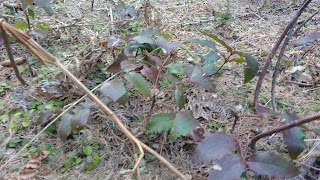MissB excitedly told me she found a mushroom tree. Sure enough, there was a birch covered in shelves of fungi.
MissB and I continued our walk through the woods to see the creek in the swamp. Speckles was happy to run and hop through the marshy flattened grasses. That grass grows five or six feet high in the summer, then is weighted down by the snows. That makes the swamp hard to explore in the warm months.
I've been checking each week for when the Swamp Lanterns would bloom, and finally they are glowing! <I>Lysichiton americanus</I> is the skunk cabbage of the western U.S.A. The eastern version is maroon in color and the plant is said to give off a chemical which warms the soil, allowing it to grow sooner than most other plants. The yellow version does not create its own heat. Our honey bees can use the swamp lanterns as an early pollen source while waiting for the nectar flow. The deer and bears eat it, too!
There is a patch of creeping mahonia in the old skid trail. <I>Mahonia repens</I> is the short version of Oregon grape. I had just enough from the patch by the back drive to make a tiny jar of jam the first summer we were here. See the flower buds starting to form? They'll be bright yellow soon, then develop into blue colored elongated berries with no crown (that circle on blueberries).
We also came across HealsAll, <I>Prunella vulgaris</I>, but it isn't yet in flower.






No comments:
Post a Comment